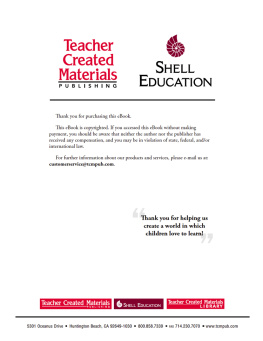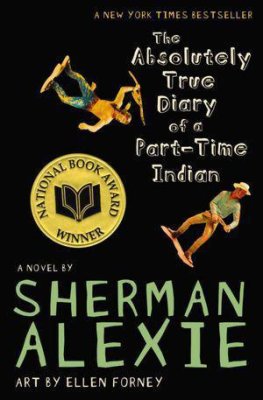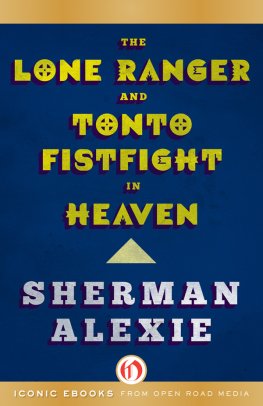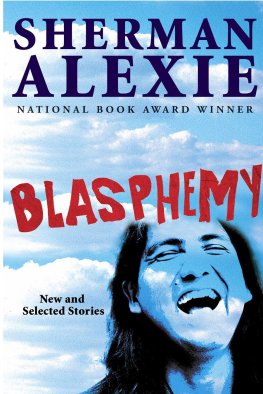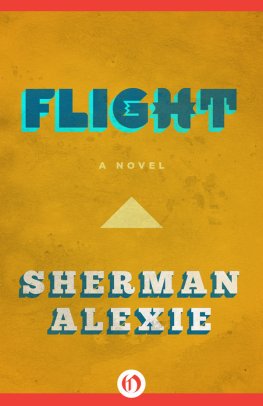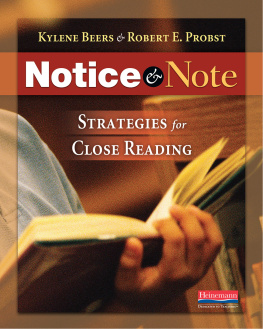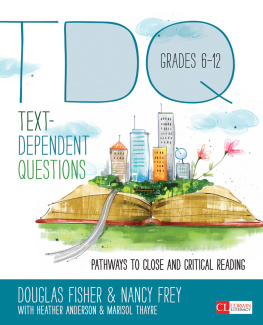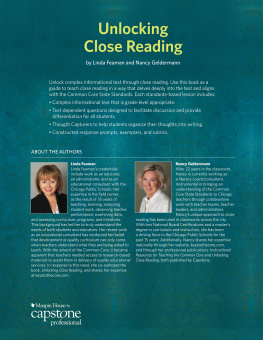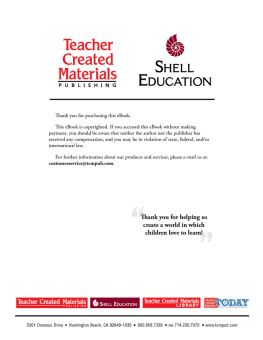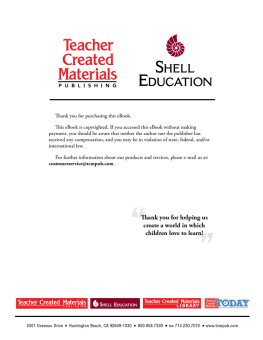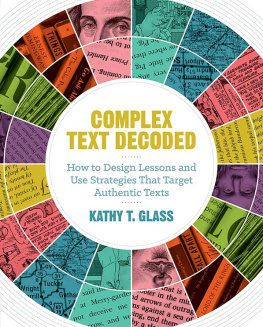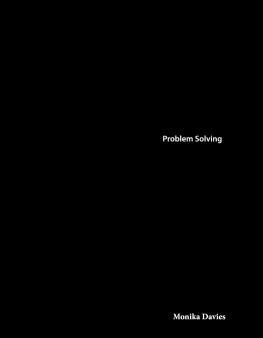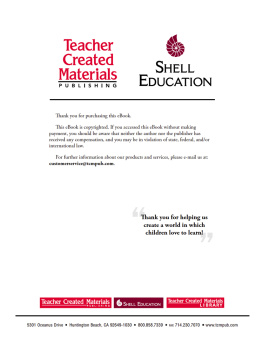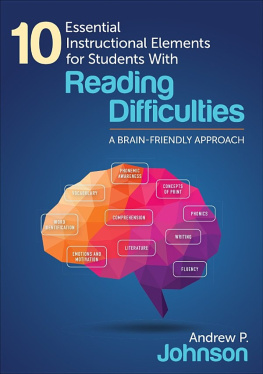
Publishing Credits
Corinne Burton, M.A.Ed., President; Conni Medina, M.A.Ed., Managing Editor; Emily R. Smith, M.A.Ed., Content Director;
Lee Aucoin, Senior Graphic Designer; Stephanie Bernard, Assistant Editor; Don Tran, Graphic Designer
Image Credits
Cover design & illustration Lee Aucoin; background image iStock
Standards
2007 Teachers of English to Speakers of Other Languages, Inc. (TESOL)
2007 Board of Regents of the University of Wisconsin System. World-Class Instructional Design and Assessment (WIDA)
Copyright 2010. National Governors Association Center for Best Practices and Council of Chief State School Officers.
All rights reserved.
Copyright 20072015. Texas Education Association (TEA). All rights reserved.
Shell Education
A division of Teacher Created Materials
5301 Oceanus Drive
Huntington Beach, CA 92649-1030
ISBN 978-1-4258-1720-6
ePUB ISBN 978-1-5457-0943-6
https://www.tcmpub.com/shell-education
2017 Shell Educational Publishing, Inc.
The classroom teacher may reproduce copies of materials in this book for classroom use only. The reproduction of any part for an entire school or school system is strictly prohibited. No part of this publication may be transmitted, stored, or recorded in any form without written permission from the publisher.
Table of Contents
Introduction
How to Use This Literature Guide
Todays standards demand rigor and relevance in the reading of complex texts. The units in this series guide teachers in a rich and deep exploration of worthwhile works of literature for classroom study. The most rigorous instruction can also be interesting and engaging!
Many current strategies for effective literacy instruction have been incorporated into these instructional guides for literature. Throughout the units, text-dependent questions are used to determine comprehension of the book as well as student interpretation of the vocabulary words. The books chosen for the series are complex and are exemplars of carefully crafted works of literature. Close reading is used throughout the units to guide students toward revisiting the text and using textual evidence to respond to prompts orally and in writing. Students must analyze the story elements in multiple assignments for each section of the book. All of these strategies work together to rigorously guide students through their study of literature.
The next few pages describe how to use this guide for a purposeful and meaningful literature study. Each section of this guide is set up in the same way to make it easier for you to implement the instruction in your classroom.
Theme Thoughts
The great works of literature used throughout this series have important themes that have been relevant to people for many years. Many of the themes will be discussed during the various sections of this instructional guide. However, it would also benefit students to have independent time to think about the key themes of the book.
Before students begin reading, have them complete the Pre-Reading Theme Thoughts (page 13). This graphic organizer will allow students to think about the themes outside the context of the story. Theyll have the opportunity to evaluate statements based on important themes and defend their opinions. Be sure to keep students papers for comparison to the Post-Reading Theme Thoughts (page 59). This graphic organizer is similar to the pre-reading activity. However, this time, students will be answering the questions from the point of view of one of the characters in the book. They have to think about how the character would feel about each statement and defend their thoughts. To conclude the activity, have students compare what they thought about the themes before they read the book to what the characters discovered during the story.
Vocabulary
Each teacher reference vocabulary overview page has definitions and sentences about how key vocabulary words are used in the section. These words should be introduced and discussed with students. Students will use these words in different activities throughout the book.
On some of the vocabulary student pages, students are asked to answer text-related questions about vocabulary words from the sections. The following question stems will help you create your own vocabulary questions if youd like to extend the discussion.
How does this word describe _____s character?
How does this word connect to the problem in this story?
How does this word help you understand the setting?
Tell me how this word connects to the main idea of this story.
What visual pictures does this word bring to your mind?
Why do you think the author used this word?
At times, you may find that more work with the words will help students understand their meanings and importance. These quick vocabulary activities are a good way to further study the words.
Students can play vocabulary concentration. Make one set of cards that has the words on them and another set with the definitions. Then, have students lay them out on the table and play concentration. The goal of the game is to match vocabulary words with their definitions. For early readers or English language learners, the two sets of cards could be the words and pictures of the words.
Students can create word journal entries about the words. Students choose words they think are important and then describe why they think each word is important within the book. Early readers or English language learners could instead draw pictures about the words in a journal.
Students can create puppets and use them to act out the vocabulary words from the stories. Students may also enjoy telling their own character-driven stories using vocabulary words from the original stories.
Analyzing the Literature
After you have read each section with students, hold a small-group or whole-class discussion. Provided on the teacher reference page for each section are leveled questions. The questions are written at two levels of complexity to allow you to decide which questions best meet the needs of your students. The Level 1 questions are typically less abstract than the Level 2 questions. These questions are focused on the various story elements, such as character, setting, and plot. Be sure to add further questions as your students discuss what theyve read. For each question, a few key points are provided for your reference as you discuss the book with students.
Reader Response
In todays classrooms, there are often great readers who are below average writers. So much time and energy is spent in classrooms getting students to read on grade level that little time is left to focus on writing skills. To help teachers include more writing in their daily literacy instruction, each section of this guide has a literature-based reader response prompt. Each of the three genres of writing is used in the reader responses within this guide: narrative, informative/explanatory, and opinion. Before students write, you may want to allow them time to draw pictures related to the topic. Book-themed writing paper is provided on page 69 if your students need more space to write.
Guided Close Reading
Within each section of this guide, it is suggested that you closely reread a portion of the text with your students. The sections to be reread are described by location within the story since there are no page numbers in these books. After rereading the section, there are a few text-dependent questions to be answered by students.

